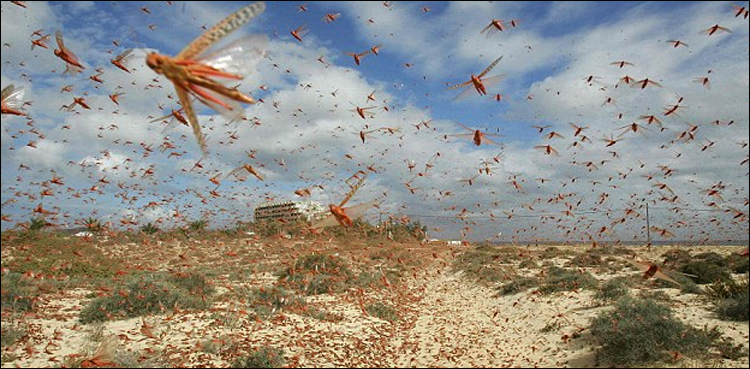Sindh to conduct aerial spray to save crops from swarms of locusts

KARACHI: The Government of Sindh has decided to conduct aerial spray after swarms of locusts landed in six districts of the province, ARY News reported on Wednesday.
Swarms of locusts have spread to several districts of Sindh including Nawabshah, Naushehro Feroz, Sanghar, Mirpur Khas, Jamshoro after initially descending in Khairpur from Balochistan, sparking fears of large-scale crop devastation in agriculture belt of the province.
A meeting co-chaired by provincial agriculture minister Muhammad Ismail Rahoo and Chief Secretary Sindh Syed Mumtaz Ali Shah discussed locusts control in various districts of Sindh.
Senior member board of revenue, secretary agriculture, DG plant protection, DG Sindh Agriculture extension were present on the occasion while divisional commissioners participated in the meeting through video link, said a statement.
The Director General Plant Protection department informed the meeting that teams and resources including the pesticides and sprays through airplanes are the parts of the locust control operation.
People in several districts of Sindh have reported descend of swarms of locusts, species of grasshoppers, which are severe threat to many agricultural crops.
The meeting also decided to survey the affected areas to assess damage to the crops.
According to reports, the swarms of locusts have inflicted damage to cotton, dates and other crops, vulnerable to the damaging insect.
It is feared that locusts will be able to destroy the agricultural belt of Sindh if they enter Mirpurkhas, Tando Allahyar, Matiari, Hyderabad and other districts on the left bank of Indus River.
According to reports, locusts first landed in Khairpur’s desert area of Nara after flying there from Balochistan. The federal government then identified 30 spots in the area where locusts were still present.
Initially from the Arabian Peninsula, the desert locusts swarmed from the Red Sea coast of Sudan and Eritria in January this year, hit Yemen, Saudi Arabia and Iran in February, and southwestern Pakistan in March, Plant Protection Department officials said.
The insects were feeding on wild bushes in Nara desert, about 20 kilometers away from the cotton crop in Sindh, department officials said.
Sindh’s lower region has vast orchards of banana, mangoes, dates etc and fields of cotton and sugarcane. Agriculture officials fear if the attack was not controlled it would destroy cotton crop and inflict extensive damage to banana and sugarcane crops.
Locusts in History
Locusts have formed plagues since prehistory. The ancient Egyptians carved them on their tombs and the insects are mentioned in ancient books and religious scriptures. Swarms have devastated crops and been a contributory cause of famines and human migrations.
Changes in agricultural practices and better surveillance of locations where swarms tend to originate, have meant that control measures can be used at an early stage. The traditional means of control are based on the use of insecticides from the ground or the air, but other methods using biological control are proving effective.
Despite modern surveillance and control methods, the potential for swarms to form is present, and when suitable climatic conditions occur and vigilance lapses, plagues can still occur.
The post Sindh to conduct aerial spray to save crops from swarms of locusts appeared first on ARYNEWS.



Post A Comment
No comments :